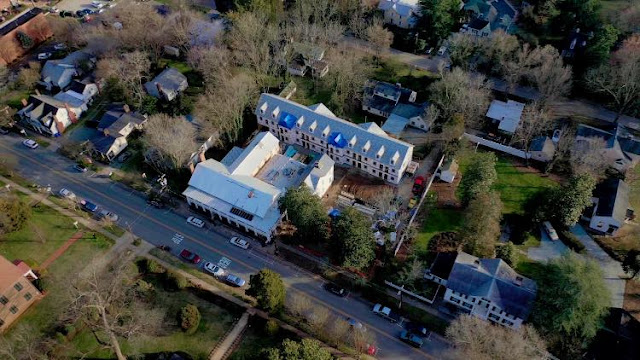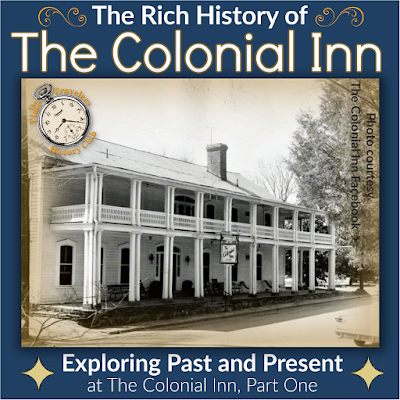Exploring Past and Present at The Colonial Inn, Part 1: History
This is Part One of a series of posts exploring The Colonial Inn's past and present. Click here for the introduction and full list of posts. Enjoy!
The Colonial Inn in Hillsborough was so much more than a dilapidated building.
If the walls could only talk, they would tell stories of many decades standing on King Street, hosting a bustling hub of locals and visitors alike. Thanks to Allied DevCorp LLC and the hard work of construction crews, this beautiful Inn is making a comeback and will hopefully stand to grow it's legacy for many more years to come. Read on to discover the rich history of The Colonial Inn and the stories that make it unique.
 |
| The Colonial Inn Sign, photo courtesy WRAL |
The exact date of the Inn's original construction is debated. The sign hanging from the front porch has advertised 1759 for as long as anyone can remember, making this early date a known but unproven legend. Known historic figures such as Aaron Burr and British General Cornwallis are rumored to have stayed at the Inn, which is possible if the Inn was established in the eighteenth century. Since Hillsborough became the seat of Orange County in 1754, it does seem likely that the original structure was built to accommodate travelers with legal business.
Elise Tyler, General Manager of The Colonial Inn, told The Time Travelers that while there is currently no solid evidence for the earlier date, they are planning to have the original beams, made of entire trees, tested to tell how old the oldest portion of the structure is.
A later date was proposed in the 1960s by local historian Mary Claire Engstrom, who spent much time digging into deeds and records to find that the earliest mention of the building is 1838. This is the date used by most historians and writers. She found convincing evidence that pointed to the lot being purchased as vacant property by Henry Shutt in 1803. He built a small hatter's shop to the side, the ruins of which supposedly survived until the early 1900s.
 |
| Orange Hotel Advertisement, The Hillsborough Recorder, October 18, 1838. Courtesy Newspapers.com |
Despite the hazy early history of Lot 15, the account of the Inn is relatively clear from 1838 to today. Isaiah Spencer purchased the property and began a successful business, called "Spencer's Tavern" by the community but "Orange Hotel" commercially. This advertisement appeared in The Hillsborough Recorder on October 18, 1838:
The subscriber would respectfully inform the public that this large and commodious establishment, situated on the street leading directly west from the Court House is now open for the reception of travelers and Regular Boarders. Having erected this building especially for a hotel, no expense or pains will be spared to give it character abroad; his customers may thereafter rest assured that his accommodations will be good.
Families desirous of spending some time in the place, may find comfortable accommodations at the Orange Hotel. ISAIAH H. SPENCER
In 1841, the Inn was bought by Richison Nichols, who added the characteristic public front porch. It changed hands again when Nichols sold it to the Hillsborough Improvement Company in 1856. Three brothers, Alfred, Henry, and Cave Stroud, renovated the hotel and advertised that the "First Class House" was situated in a prime location on "the handsomest street in town." Advertisements in The Hillsborough Recorder show that the Orange Hotel was not only a navigational point in Hillsborough, but a prominent gathering place for the community, a legacy that has lasted.
 |
| Photograph of "Strayhorn's Hotel" in 1870 |
The Strouds lost the hotel in 1868 from bankruptcy, a common occurrence in the years following the Civil War. Details of ownership of the property during the next decade are fuzzy, but historians are relatively sure that local businessmen Charles M. Latimer and Henry N. Brown bought it in 1870 for $2,600. It seems that the Inn went by the name "Strayhorn's Hotel" at this time. This may be because William Strayhorn operated the hotel for Latimer and Brown, which seems likely based on evidence found in census records and and other primary sources. Strayhorn and his family had previously been living in the home Twin Chimneys across King Street, and may have moved into the Inn in 1870.
 |
| 1884 advertisement in the Orange County Observer for the Occoneechee Hotel Courtesy Newspapers.com |
David C. Parks bought the property in 1872 after a New York investor's ownership of a few short months. A woman, Emily H. Pogue, ran the Inn from 1885-88 before selling it back to Parks. It was around this time that it changed names yet again and became known as the "Occoneechee Hotel."
 |
| 1888 Sanborn map showing Occoneechee Hotel complex Courtesy North Carolina Map Collection |
Parks expanded the hotel complex by adding multiple other buildings on the block and also enacted various renovations to the original building. He hired interior designer Jule Gilmer Korner (also known as Rueben Rink) to update the structure now recognizable for the characteristic doors, long windows, columns, second story porch, and other architectural details that he added.
 |
| Korner's Folly - Jules Korner's self-designed home Courtesy Korner's Folly.org |
Korner had a reputation for drastic and eccentric work, perhaps especially noticeable in his own home, a rare existing example of his creativity outside of the Colonial Inn: Korner's Folly in Kernersville, North Carolina. Korner's company, Reubin Rink Decorating & House Furnishing Co., revived at least six other buildings in Hillsborough around the same time, but the Inn may be the only surviving one. These changes make the Colonial Inn much more than a building, but a witness to changing times and styles.
 |
| 1894 Sanborn map showing single Occoneechee Hotel building Courtesy North Carolina Map Collection |
By 1894, the Occoneechee Hotel had gone back to the single two-story building you see today rather than a grouping of the main structure and various outbuildings. The new owners, Thomas A. Corbin and H. L. Aker, made more additions to the Inn in 1908. The name became "Corbinton Inn" as a nod to both the owner and the colonial name of the town Corbinton prior to Hillsborough.
 |
| The Corbinton Inn on King Street, 1915 Courtesy Open Orange NC.org |
W. L. Foushee bought the property in 1921 and just three years later, the final, familiar name of the hotel appeared on a 1924 Sanborn map: The Colonial Inn. It has been known by this title for nearly 100 years.
The Colonial Inn changed hands and continued growing throughout the twentieth century. The man who bought the Inn from Foushee in 1946, Paul Henderson, added a sophisticated restaurant to the business and made repairs to the now-large building. The next two families to own the Inn continued to grow both the building and business. Charles and Ann Crawford operated the restaurant portion of the Inn so successfully that it became a popular Sunday dinner spot that drew guests from farther than the immediate Hillsborough for years to come. James and Maxine Freeland bought the Inn from the Crawfords in 1969 and added a elegant banquet room to the back that after the current renovations, will still serve it's original purpose of being a beautiful space for everything from dinners to weddings.
 |
| The Colonial Inn in the 1960s Courtesy Open Orange NC.org |
Many still remember getting married in the Colonial Inn, sharing Sunday meals with family, and creating other special memories in the historic building and were most likely grieved to see it close it's wooden doors in 2001. Two years later, the property sold to Francis Henry and the community was further saddened to watch the structure sit abandoned.
 |
| The Colonial Inn in disrepair, 2016 Courtesy Open Orange NC.org |
But Hillsborough did not just stand and watch as an important piece of their heritage was neglected and left for ruin. Beginning in 2003, locals took action to save the Inn. The building was honored with a "Statewide Significance" recognition before multiple formal complaints were made against the owner's treatment of the valued property. 153 W. King Street was a topic brought before town and county government off and on for over ten years before the process of eminent domain began in October of 2015.
 |
| Aerial photo of The Colonial Inn, 2020 Courtesy The Colonial Facebook page |
The town agreed in May 2017 to hold off on enacting eminent domain as long as Henry sold the property within the time frame of a year. When Allied DevCorp. LLC bought Lot 15 in January 2018 for $800,000, not only was the Colonial Inn saved, but it entered a phase of restoration and new life that aims to display the beauty and strength of a building that has brought people together for at least 182 years. As the general manager and passionate Colonial Inn historian Elise Tyler told us, "It's legacy is bigger than all of us."
Doesn't the rich history of the Colonial Inn make you appreciate how it's story is continuing? We would love to hear your opinion in the comments!
Next Post: Saving the Colonial Inn, the First Time >
Sources:
The Colonial Inn Facebook page
The Colonial Inn: Its History and Significance by Cathleen Turner
The Colonial Inn of Hillsborough, N.C. - Digital NC
Colonial Inn Remake - The Herald Sun
Elise Tyler, General Manager of The Colonial Inn
Hillsboro, N.C., March 1888 Sanborn map - North Carolina Map Collection
Hillsboro, Orange Co., N.C., April 1894
The Hillsborough Recorder, October 18, 1838 - Newspapers.com
Historic Hillsborough Inn Getting Long-Awaited Makeover - WRAL
Orange County Observer, December 20, 1884 - Newspapers.com
Sale Begins New Chapter for Hillsborough’s Colonial Inn - The Herald Sun





Comments
Post a Comment